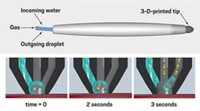Advertisement
Grab your lab coat. Let's get started
Welcome!
Welcome!
Create an account below to get 6 C&EN articles per month, receive newsletters and more - all free.
It seems this is your first time logging in online. Please enter the following information to continue.
As an ACS member you automatically get access to this site. All we need is few more details to create your reading experience.
Not you? Sign in with a different account.
Not you? Sign in with a different account.
ERROR 1
ERROR 1
ERROR 2
ERROR 2
ERROR 2
ERROR 2
ERROR 2
Password and Confirm password must match.
If you have an ACS member number, please enter it here so we can link this account to your membership. (optional)
ERROR 2
ACS values your privacy. By submitting your information, you are gaining access to C&EN and subscribing to our weekly newsletter. We use the information you provide to make your reading experience better, and we will never sell your data to third party members.
Analytical Chemistry
Mapping Drugs In Human Tissue
Clinical Chemistry: Mass spectrometry imaging provides view of an inhaled drug in human lung tissue
by Christine Herman
October 12, 2011

Tracking a drug’s destination in human tissue is now possible thanks to mass spectrometry imaging (Anal. Chem., DOI: 10.1021/ac2014349).
Scientists want to track drugs to find out whether they reach their intended targets in specific tissues. Doctors also think such mapping could help them tailor medicine to their patients. Traditional imaging techniques require adding a chemical label to the drug. However, these labels can change the drug’s behavior.
Researchers led by György Marko-Varga from Lund University, in Sweden, wanted to develop a label-free method. So they harnessed matrix-assisted laser desorption ionization (MALDI) mass spectrometry imaging to map the fate of an inhaled drug in tissue biopsies from five patients’ lungs.
The patients, who were long-time smokers, reported improved breathing after inhaling ipratropium, a common drug that opens airways in the lungs by binding to receptors in smooth muscle tissue. Researchers analyzed 3,000 0.01-mm2 spots on each tissue sample to create an image showing the drug’s spatial distribution in the tissue. Their maps found that the drug had reached smooth muscle tissue in four of the patients.
The team had previously tested its technique on the tissues of rats given drug doses 100 times greater than those used in this study (Plos One, DOI: 10.1371/journal.pone.0011411). In the two years since then, the team improved the technique’s sensitivity so that they can image therapeutic doses in humans, says Thomas Fehniger, from Tallin University of Technology, in Estonia, who is first author of the study. The technique, he says, could help doctors understand which tissues a drug targets so that they can choose the right drug for each patient’s condition.




Join the conversation
Contact the reporter
Submit a Letter to the Editor for publication
Engage with us on Twitter